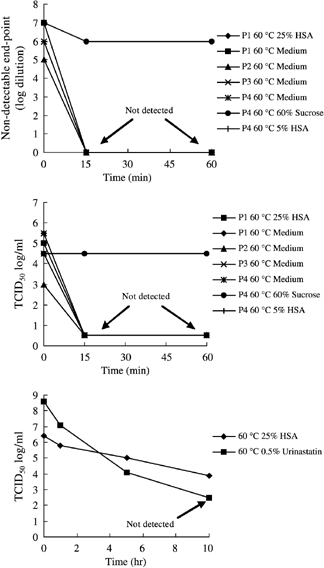Heat sensitivity of human parvovirus B19
Vox Sanguinis 2003; 84: 164–169
Table 1 and Figure 2 of this paper were incorrect when the paper was published. Correct versions of these are given below and on the following page.
| Complete medium | PBS | HSA | 60%sucrose | |||||||||||||||||||
|---|---|---|---|---|---|---|---|---|---|---|---|---|---|---|---|---|---|---|---|---|---|---|
| 25% | 5% | |||||||||||||||||||||
| Plasma no.: | P1 | P1 | P1a | P1 | P1 | P2 | P1 | P2 | P3 | P4 | P4 | P1 | P1 | P1 | P1 | P1 | P1 | P1 | P1 | P1 | P4 | P4 |
| exp. no.: | #1 | #2 | #2 | #3 | #4 | #4 | #5 | #5 | #5 | #5 | #6 | #1 | #7 | #8 | #8 | #4 | #5 | #7 | #8 | #8 | #6 | #6 |
| Heating | ||||||||||||||||||||||
| condition | ||||||||||||||||||||||
| 60 °C | ||||||||||||||||||||||
| 0 min | 6·0 | 6·0 | 4·7 | 4·5 | 5·0 | 2·5 | 5·5 | 3·0 | 4·5 | 5·5 | 5·0 | 5·7 | 5·5 | 5·5 | 2·7b | 5·3 | 5·0 | 6·5 | 5.3 | 2·5b | 5·0 | 4·5 |
| (7) | (5) | (6) | (6) | (6) | (7) | (6) | (7) | |||||||||||||||
| 15 min | < 0·5c | < 0·5 | < 0·5 | < 0·5 | < 0·5 | < 0·5 | < 0·5 | < 0·5 | < 0·5 | < 0·5 | < 0·5 | < 0·5c | < 0·5c | < 0·5c | < 0·5 | < 0·5 | < 0·5c | < 0·5c | < 0·5 | 4·5 | ||
| (0) | (0) | (0) | (0) | (0) | (0) | (0) | (6) | |||||||||||||||
| 60 min | < 0·5 | < 0·5d | < 0·5d | < 0·5 | < 0·5 | < 0·5 | < 0·5 | < 0·5 | < 0·5 | < 0·5 | < 0·5d | < 0·5 | < 0·5 | < 0·5 | < 0·5 | < 0·5 | 4·5 | |||||
| (0) | (0) | (0) | (0) | (0) | (6) | |||||||||||||||||
| LRF | ≥ 5·5 | ≥ 5·5 | ≥ 4·2 | ≥ 4·0 | ≥ 4·5 | ≥ 2·0 | ≥ 5·0 | ≥ 2·5 | ≥ 4·0 | ≥ 5·0 | ≥ 4·5 | ≥ 5·2 | ≥ 5·0 | ≥ 5·0 | ≥ 2·2 | ≥ 4·8 | ≥ 4·5 | ≥ 6·0 | ≥ 4·8 | ≥ 2·0 | ≥ 4·5 | 0·0 |
| (≥ 7) | (≥ 5) | (≥ 6) | (≥ 6) | (≥ 6) | (≥ 7) | (≥ 6) | (1) | |||||||||||||||
| Heating | ||||||||||||||||||||||
| condition | ||||||||||||||||||||||
| 37 °C | ||||||||||||||||||||||
| 60 min | 5·5 | 4·7e | 4·3d | 5·5 | 5·0 | 5·5d | 5·5 | 4·5 | 4·8 | |||||||||||||
| (6) | (7) | (6) | (6) | |||||||||||||||||||
- Data represent log10 tissue culture infective dose 50% (TCID50)/ml calculated from results of an indirect immunofluorescence assay (IFA) (upper figure) and log10 end-point of reverse transcription–polymerase chain reaction (RT–PCR) results (the value shown in parentheses).
- HSA, human serum albumin; LRF, log-reduction factor; PBS, phosphate-buffered saline.
- a Ultracentrifuged.
- b 1/1000 spiked.
- c 10 min.
- d 70 min.
- e 180 min.

Reduction in the infectivity titres of parvovirus B19 (B19) and canine parvovirus (CPV) following heating in different solutions, as shown on the Figure. (top) Reduction in B19 infectivity titre after heating at 60 °C, as measured by reverse transcription–polymerase chain reaction (RT–PCR). (middle) Reduction in B19 infectivity titre after heating at 60 °C, as measured by an indirect immunofluorescence assay (IFA). (bottom) Reduction in CPV infectivity titre after heating at 60 °C. HSA, human serum albumin; TCID50, tissue culture infective dose 50%.




